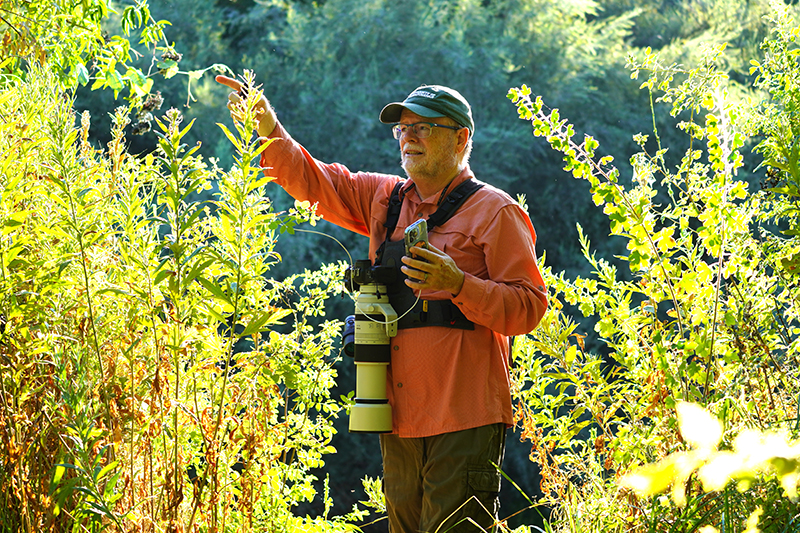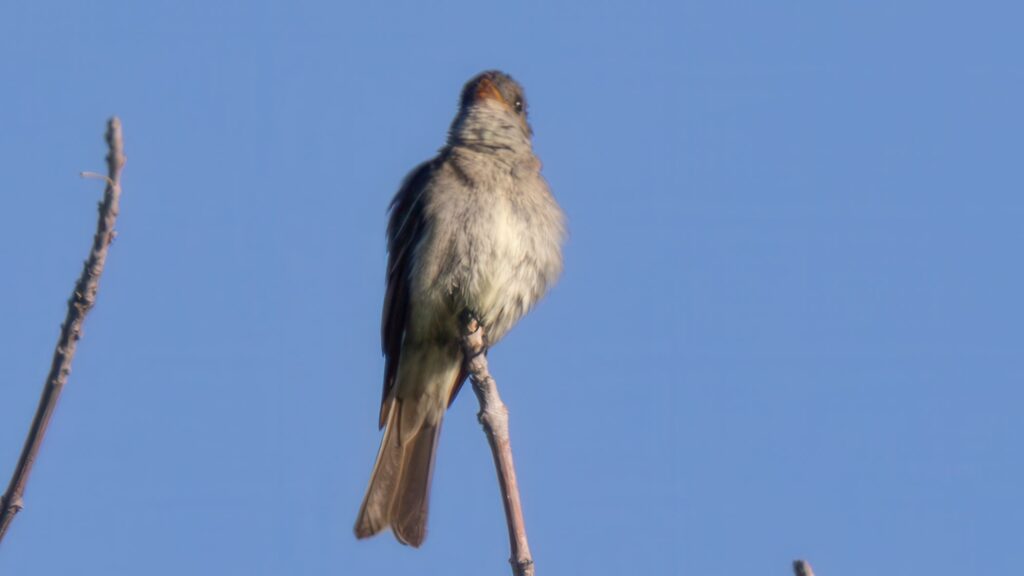Jim Gain knew it was remotely possible that an Eastern Wood-Peewee might appear in San Joaquin County, but since the last reliable sighting had been in 1983, he thought the report he saw on e-bird last Saturday was almost certainly an error. The report was from a person whose name Gain didn’t recognize, which added to his doubt. Gain knows most of the state’s elite birders, if not personally, at least by name and reputation.
E-bird is the communications network for birders throughout the nation and beyond. Avid birders like Jim Gain follow it for news of birds they might need to add to state or county lists. Gain’s home turf is Stanislaus County. Adjacent counties like San Joaquin and Merced keep him busy as well, since the chase to add one more species is one of birding’s many attractions.
Among the esoterica in the arcane world of rare birding, the knowledge that Western Wood-Peewees and Eastern Wood-Peewees are virtually indistinguishable in the field is fundamental. The only reliable way to tell them apart is by their songs and call notes. A Wood-Peewee in the west is 99.99% always going to be a Western Wood-Peewee. Eastern Wood-Peewees seldom venture farther from home than the eastern Midwest. Jim Gain knew this, of course, and that’s why he discounted the e-bird report as an error.
Then he saw the sonogram.

Like e-bird, sonograms and digital photography are part of the new technology that has made birding more accessible and fun to the millions of nature lovers who enjoy birds as gems in the glittering crown of nature’s majesty. Phone apps have made bird identification much easier, as new technology has introduced more people to the fascinating lives of creatures some have called “feathered jewels.”
Once he saw the sonogram confirming the identification of the extremely rare Eastern Wood Peewee just across the Stanislaus River from his home county, Jim Gain knew he had to search for it. He just hoped it would linger long enough for him to get it on Sunday, the first free day he had for the chase.
Early Sunday morning, Gain arrived at the park in Ripon where the bird had been found. He had binoculars, his camera and 400mm Canon lens, and his own recording equipment. He also had the GPS coordinates that led him down the park trails to the Peewee’s precise location.
Searching the riparian forest of oak, willow, elderberry and cottonwoods, it wasn’t long before Gain heard the plaintive call of the Eastern Wood-Peewee. He readied his camera. One of the Valley’s finest nature photographers, Jim Gain is especially gifted at capturing small birds, which are among nature’s most difficult subjects for photography. (see Jim Gain’s work here)

At first, Gain spotted the Peewee in an oak, just a few feet north of the Stanislaus River. It then flew to the exposed branches of a nearby cottonwood, and perched. Gain trained his experienced eyes and trusty lens on the diminutive bird and got his usual fine photos. He then managed to record its song and calls.
It turned out that the mystery birder who had found the Peewee was from Petaluma. Though Gain hadn’t recognized the name — Colin Meusel — in a fortuitous coincidence, Mr. Meusel had heard Eastern Wood Peewees every day for a week while in Maine during the summer of 2023. He described the song as, “more plaintive, slower” and “longer,” than that of the Western Wood-Peewee. He’d also had the presence of mind and equipment to record the bird’s song to confirm his find, for which many of the Valley’s most hard core birders were grateful, as the rush to see and hear the ultra-rarity began not long after his e-bird report.
As for Jim Gain, he was able to add another species to his California and San Joaquin County lists. Once he had found the bird, he did spend more than a few minutes trying to will it across the river into Stanislaus County, where he has listed over 300 species of birds (and photographed most of them).
Gain also acquired a sonogram of his own, just in case anyone might doubt such an unlikely sighting. After all, birders are a skeptical lot, especially when a bird might show up only every forty-one years or so. Especially then.

I’m beginning to share the excitement of seeing a bird out of its territory. The Yellow Crowned Night Heron belongs in the Southeast and I’m in Albuquerque, yet a month ago it popped into view in front of me fishing in a ditch where I was walking my dogs. It took a while to confirm it from my photos, but the hunt to verify was fun. The folks at eBird even emailed me because they had flagged it as being out of the territory.
I’m happy to have Cornell’s app on my phone. So many birds perch in locations that are nearly invisible from the ground I find the sonograms priceless—though I would love to see the little peckers. 😁
I can count on gaining more and more knowledge from Jim Gain’s wisdom about our birds, birders, eBird, and, now, even equipment.
Fascinating to think an Eastern bird would travel all the way to our valley, and, be identified by a sonagram picking up its sound pattern. I am well pleased, as always, to click on this regular feature of the Valley Citizen.
Thank you, Jim Gain, Colin Meusel, Augusta Farley, Cindy, and Eric Caine, for your contributions.